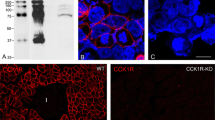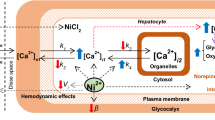Summary
The binding of125I-glucagon to the cell surface and the pathway of intracellular transport of this hormone by rat hepatocytes in vivo were studied by light and EM autoradiography. Radiolabeled glucagon injected into the blood stream was taken up predominantly by the hepatocytes. Negligible radioactivity was found to be associated with other cell types such as endothelial or Kupffer cells. Our results indicate that at early time points after injection glucagon has been preferentially interacting with the sinusoidal domain of the hepatocytes and found to be associated with coated pits and uncoated vesicles corresponding to endosomes. At 15–20 min time intervals glucagon grains were found within hepatocyte interior. Later, at 30 min after injection glucagon grains accumulate in the Golgi-lysosomal region of hepatocyte often in close proximity to the opening of the bile canaliculi. Accordingly a portion of internalized125I-glucagon was found to be released into the bile thereby indicating that a transcytotic pathway may be involved in this peptide's clearance process.
Similar content being viewed by others
References
Ackerman GA, Yang J, Wolken KW (1983) Differential surface labeling and internalization of glucagon by peripheral leucocytes. J Histochem Cytochem 31: 433–440
Amherdt M, Patel Y, Orci L (1989) Binding and internalization of somatostatin, insulin, and glucagon by cultured rat islet cells. J Clin Invest 84: 412–417
Assan R (1972) In vivo metabolism of glucagon. In: Lefebvre PJ, Unger RH (eds) Glucagon. Molecular, physiology, clinical and therapeutic implications. Pergamon, Oxford, pp 47–59
Authier F, Desbuqois B (1991) Degradation of glucagon in isolated liver endosomes. ATP-dependance and partial characterization of degradation products. Biochem J 280: 211–218
—, Janicot M, Lederer M, Desbuqois B (1990) Fate of injected glucagon taken up by the rat liver in vivo. Biochem J 272: 703–712
—, Desbuqois B, De Galle B (1992) Ligand-mediated internalization of glucagon receptors in intact rat liver. Endocrinology 131: 447–457
Barazzone P, Gordon P, Carpentier J-L, Orci L, Freychet P, Canivet B (1980) Binding, internalization and lysosomal association of125I-glucagon in isolated rat hepatocytes. J Clin Invest 66: 1081–1093
Bergeron JJM, Sikstrom R, Hand AR, Posner BI (1979) Binding and uptake of125I-insulin into rat liver hepatocytes and endothelium. J Cell Biol 80: 427–443
—, Cruz J, Khan MN, Posner BI (1985) Uptake of insulin and other ligands into receptor-rich endocytic components of target cells: the endosomal apparatus. Annu Rev Physiol 47: 383–403
Buchanan KD, Vance JE, Morgan A, Williams RH (1968) Effect of pancreozymin on insulin and glucagon levels in blood and bile. Am J Physiol 215: 1293–1298
Burwen SJ, Barker ME, Goldman IS, Hradek GT, Raper SE, Jones AL (1984) Transport of epidermal growth factor by rat liver: evidence for a nonlysosomal pathway. J Cell Biol 99: 1259–1265
Dunn WA, Hubbard AL (1984) Receptor mediated endocytosis of epidermal growth factor by hepatocytes in the perfused rat liver: ligand and receptor dynamics. J Cell Biol 98: 2148–2159
Hubbard AL, Stukenbrok H (1979) An electron microscope autoradiographic study of the carbohydrate recognition systems in rat liver. J Cell Biol 83: 65–81
Iwanij V, Hur KC (1985) Direct cross-linking of125I-labeled glucagon to its membrane receptor by UV irradiation. Proc Natl Acad Sci USA 82: 325–329
Jaspan JB, Polonsky KS, Lewis M, Pensler J, Pugh W, Moosa AR, Rubenstein AH (1981) Hepatic metabolism of glucagon in the dog: contribution of the liver to overall metabolic disposal of glucagon. Am J Physiol 240: E233-E244
Lefebvre PJ, Luyckx AS (1983) The renal handling of glucagon. In: Lefebvre PJ (ed) Glucagon. Springer, Berlin Heidelberg New York Tokyo, pp 389–396 [Born GV et al (eds) Handbook of experimental pharmacology, vol 66]
Lin MC, Wright DE, Hruby VJ, Rodbell M (1975) Structure-function relationships in glucagon: properties of highly purified Des-His1-, monoiodo-, and [Des-Asn28, Thr29] (homoserine lactone27)-glucagon. Biochemistry 14: 1559–1563
Lipson KE, Kolhatkar AA, Cherksey BD, Donner DB (1986) Characterization of glucagon receptors in Golgi fraction of rat liver, evidence for the receptors that are uncoupled from adenylate cyclase. Biochemistry 25: 2612–2620
Marco J, Diego J, Villaneuva M, Diaz-Fierros M, Valverde I, Segovia J (1973) Elevated plasma glucagon in cirrhosis of the liver. N Engl J Med 289: 1107–1111
Patel Y, Amherdt M, Orci L (1982) Quantitative electron microscopic autoradiography of insulin, glucagon, and somatostatin binding sites on islets. Science 217: 1155–1156
Renston RH, Maloney DG, Jones AL, Hradek GT, Wong KY, Goldfine ID (1980 a) Bile secretory apparatus: evidence for a vesicular transport mechanism for proteins in the rat, using horseradish peroxidase and (125I) insulin. Gastroenterology 78: 1373–1388
Renston RH, Jones AL, Christiansen WD, Hradek GT, Underdown BJ (1980b) Evidence for a vesicular transport mechanism in hepatocytes for biliary secretion of immunoglobulin A. Science 208: 1276–1278
Salpeter MM, McHenry FA (1973) Electron microscope autoradiography. In: Kochler JK (ed) Advanced techniques in biological electron microscopy. Springer, Berlin Heidelberg New York, pp 14–152
Smith GD, Evans WH, Peters TJ (1980) Ligand-induced changes at the hepatocyte sinusoidal plasma membrane. FEBS Lett 120: 104–106
Sztul E, Kaplin A, Saucan L, Palade G (1991) Protein traffic between distinct plasma membrane domains: isolation and characterization of vesicular carriers involved in transcytosis. Cell 64: 81–89
Unger RH, Orci L (1976) Physiology and pathophysiology of glucagon. Physiol Rev 56: 778–826
Watanabe J, Kanamura S, Asada-Kubota M, Kanai K, Oka M (1984) Receptor-mediated endocytosis of glucagon in isolated mouse hepatocytes. Anat Rec 210: 557–567
Author information
Authors and Affiliations
Rights and permissions
About this article
Cite this article
Iwanij, V., Stukenbrok, H. Uptake and transport of glucagon by rat liver: evidence for transcytotic pathway. Protoplasma 188, 202–212 (1995). https://doi.org/10.1007/BF01280372
Received:
Accepted:
Issue Date:
DOI: https://doi.org/10.1007/BF01280372




